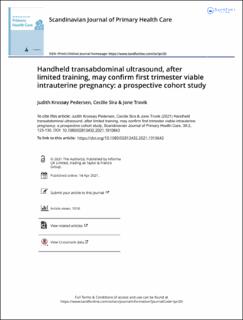| dc.contributor.author | Pedersen, Judith Krossøy | |
| dc.contributor.author | Sira, Cecilie | |
| dc.contributor.author | Trovik, Jone | |
| dc.date.accessioned | 2022-04-12T09:46:12Z | |
| dc.date.available | 2022-04-12T09:46:12Z | |
| dc.date.created | 2021-07-09T19:10:32Z | |
| dc.date.issued | 2021 | |
| dc.identifier.issn | 0281-3432 | |
| dc.identifier.uri | https://hdl.handle.net/11250/2991044 | |
| dc.description.abstract | Objectives
Handheld point-of-care abdominal ultrasound (POCUS) may be used by primary care physicians while vaginal ultrasound is limited to use in specialist care. We aimed to compare abdominal handheld ultrasound to vaginal ultrasound in determining first trimester viable intrauterine pregnancy and estimate gestational length.
Design
Prospective cohort study.
Setting
Gynaecologic outpatient clinic; women referred from GPs during early pregnancy. Handheld ultrasound using VscanExtend® was performed by fourth-year medical students with limited training. Transvaginal ultrasound using high-end devices was performed by ordinary hospital staff.
Subjects
Women in the first trimester of pregnancy referred for termination of pregnancy or with symptoms of early pregnancy complications.
Main outcome measures
Rate of confirming vital intrauterine pregnancy (visualizing foetal heart beats) and measurement of crown-rump length (CRL) using handheld abdominal versus vaginal ultrasound.
Results
In all 100 women were included; 86 confirmed as viable intrauterine pregnancies and 14 pathological pregnancies (miscarriages/extrauterine pregnancies). Handheld abdominal ultrasound detected fetal heartbeats in 63/86 (73% sensitivity) of healthy pregnancies and confirmed lack of fetal heartbeats in all pathological pregnancies, total positive predictive value (PPV) 100% and total negative predictive value (NPV) 38%. From gestational week 7, handheld abdominal ultrasound confirmed vitality in 51/54 patients: PPV 100% and NPV 79%. CRL (n = 62) was median 1 mm shorter (95% confidence interval 1–2 mm) measured by handheld abdominal versus vaginal ultrasound.
Conclusion
Handheld ultrasound has an excellent prediction confirming viable intrauterine pregnancy from gestational week 7. Validation studies are needed to confirm whether the method is suitable in primary care assessing early pregnancy complications. | en_US |
| dc.language.iso | eng | en_US |
| dc.publisher | Taylor & Francis | en_US |
| dc.rights | Navngivelse 4.0 Internasjonal | * |
| dc.rights.uri | http://creativecommons.org/licenses/by/4.0/deed.no | * |
| dc.title | Handheld transabdominal ultrasound, after limited training, may confirm first trimester viable intrauterine pregnancy: a prospective cohort study | en_US |
| dc.type | Journal article | en_US |
| dc.type | Peer reviewed | en_US |
| dc.description.version | publishedVersion | en_US |
| dc.rights.holder | Copyright 2021 The Author(s) | en_US |
| cristin.ispublished | true | |
| cristin.fulltext | original | |
| cristin.qualitycode | 1 | |
| dc.identifier.doi | 10.1080/02813432.2021.1910643 | |
| dc.identifier.cristin | 1921261 | |
| dc.source.journal | Scandinavian Journal of Primary Health Care | en_US |
| dc.source.pagenumber | 123-130 | en_US |
| dc.identifier.citation | Scandinavian Journal of Primary Health Care. 2021, 39 (2), 123-130. | en_US |
| dc.source.volume | 39 | en_US |
| dc.source.issue | 2 | en_US |

